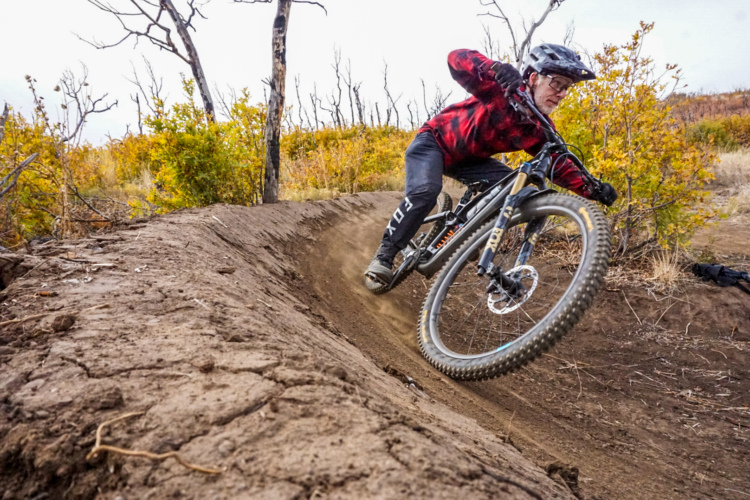
If mountain bikes are a luxury, then fat bikes are a corner suite at the Wynn, with a five-star breakfast delivered to your couch while you think about which sports car you want to rent for the day. In other words, they’re unnecessary. Fat bikes, for most of us, compliment the other bikes in the garage, rather than define the garage. Like most “unnecessary” items in life, they are meant for fun and entertainment, and the Diamondback El Oso delivers this luxury at a reasonable price.
The El Oso fleet has been in the Diamondback lineup for a while, but the bikes have seen a revision in the past few years and are now represented with the Uno, Dos, and Tres designations rather than Grande, Gordo, and De Acero. The three El Osos (bears) are all distinct in build kit and intent.
The $850 El Oso Uno is a base level fat bike with a steel frame and fork, mechanical disc brakes, a 2×9 drivetrain, and “cruiser” tires. The $2,000 El Oso Tres is a more aggressive version of the fat bike, with an aluminum frame, a 100mm travel Manitou fork, a 1×11 drivetrain, Maxxis Minion FBF and FBR tires, and Shimano hydraulic brakes. El Oso models are available for purchase at Diamondback.com, REI, and other online retailers.
About the El Oso Dos

The El Oso Dos that I have been riding obviously fits in the middle, for $1,500. The build kit on the aluminum Dos suggests that it is made for mountainous fat biking. There are hydraulic TRP Slate disc brakes, and 26×4.5″ Kenda Juggernaut tires. Riders can fit up to five-inch-wide tires.
In the rear, Diamondback fit a 10-speed, 11-42T cassette to a 2-speed, 24/36T chainring in the front. There is absolutely no suspension, and no dropper post, so it is a true fully-rigid bike, and the 740mm-wide handlebars and 70mm stem compliment its XC style.
On my medium test bike, the Dos has a tall-ish standover height of 804mm, a head tube angle of 68.5°, a seat tube angle of 74°, a short-ish wheelbase of 1,155mm, a chainstay lengh of 460mm, and a conservative reach of 434mm.
That’s a lot of adjectives to describe the geometry, and some of them were selected in relevance to more modern full-suspension mountain bikes. Fat bike geometry has not progressed like full-suspension geometry, but as I’ve found, it hasn’t been all that necessary.
Riding the Bear

Most of us aren’t riding a fat bike like a full-suspension trail bike, or even a hardtail in the peak of our summer performance. The XC-nature of the geometry and components on the El Oso give it a much more responsive feel which could be easy to lose on a bike with 4.5-inch-wide tires.
While the reach of the bike on paper at 434mm seems short, with the 70mm stem, the cockpit of the El Oso never felt cramped for my 5’8″ height in the medium frame. While I generally want nothing to do with bikes that come with a 70mm stem, the traction is better displaced on the front end and it makes for a comfortable climbing position.
I won’t say it’s the perfect set up. The 740mm wide handlebars could be wider. I think 750mm wide bars, and a 60mm stem would also work well on the El Oso and give it a more modern trail bike feel.

Uphill traction is pretty solid, depending on the conditions of course. I ran the Kenda Juggernauts with about 7.5psi and they have a solid amount of bite in them in the snow, aside from the occasional slip in a standing uphill climb or around a corner.
The El Oso still feels slack enough for a fun and sketchy descent every now and then, even though you’ll certainly be over the bars more with the longer stem. You’ll also be up nice and high with the rigid post unless you’ve dropped it before a descent.
Where the El Oso shines is through rolling climbs and descents and swooping corners. The tires may be fat, but as a whole, the Bear feels responsive and lively with its geometry.

I didn’t have problems with any of the components. Even the quick release on the seat post feels pretty nice. The Shimano 2×10 drivetrain didn’t throw me any surprises, for better or worse. The performance met what I’d expect from a Deore 2×10 drivetrain. It’s pretty smooth and fast but not too fast.
I do feel like it’d be worth it for Diamondback to entertain the idea of a 1x drivetrain, or a dropper post on the El Oso. $1,500 obviously isn’t a lot for a new bike, but considering that it’s fully rigid and fat bike technology isn’t all that exclusive anymore, a 1x drivetrain or base-level dropper post seem possible at this price point and either one would make a huge difference in the ride experience.
The prized component on the El Oso are the TRP brakes, which are reliable, powerful, and have good modulation. That said, I’d still sacrifice some braking performance for a better drivetrain or a dropper post.
Final word

For $1,500, the Diamondback El Oso Dos is a pretty comfortable spend, considering that the fat bike will probably be a third or fourth bike for someone who just wants to get out in the winter. El Oso riders can have a blast with the bike out of the box, or buy a few small upgrades to make an already fun bike even more fun.
⭐️ Find the Diamondback El Oso at Diamondback.com, REI, and other online retailers.














1 Comments
Feb 28, 2020
https://www.youtube.com/watch?v=ZkEdOezpaVc